March is Women’s History month nationally, and we wish to celebrate this in honoring three extraordinary women who made history in our Town, spanning three centuries from the American Revolution to the early twentieth century: Dorcas Seabury Soule, Calista Church Cottrell, and Lydia B. Essex.
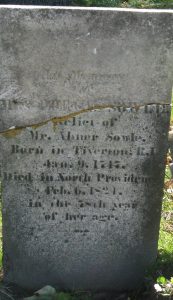 Dorcas Seabury was born in Tiverton in 1748. Her parents were Sion Seabury of Little Compton and Anna Butts of Portsmouth. She married Abner Sowle/Soule in 1766 and lived with him in the 1770 house he built at Tiverton Four Corners (now known as the Soule-Seabury House). Abner was a blacksmith, Revolutionary War soldier, whaleman, and a descendant of George Soule, who came to America on the Mayflower in 1620. Abner and Dorcas had eleven children, including twin sons, Seabury and Cornelius. Seven children had been born by 1778. Abner served as a private in the Revolution under Captain Isaac Cook and Colonel Nathan Miller.
Dorcas Seabury was born in Tiverton in 1748. Her parents were Sion Seabury of Little Compton and Anna Butts of Portsmouth. She married Abner Sowle/Soule in 1766 and lived with him in the 1770 house he built at Tiverton Four Corners (now known as the Soule-Seabury House). Abner was a blacksmith, Revolutionary War soldier, whaleman, and a descendant of George Soule, who came to America on the Mayflower in 1620. Abner and Dorcas had eleven children, including twin sons, Seabury and Cornelius. Seven children had been born by 1778. Abner served as a private in the Revolution under Captain Isaac Cook and Colonel Nathan Miller.
But it is the story of Abner’s brave and quick-thinking wife Dorcas that helped the American forces in the Revolution.
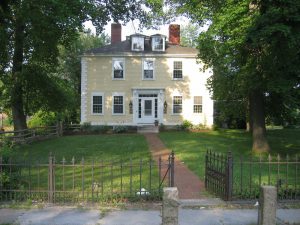 Their house was located on the northeast corner of the intersection at Tiverton Four Corners, so it was no surprise that one day a stranger appeared at her door asking for food, as he was hungry. After seating him, she asked him his name, but became suspicious upon his answer: “Touch me not.” Thinking quickly, she went out to the barn and got some horse reins. She returned to the house and tied him up from behind, as his back was to the door.
Their house was located on the northeast corner of the intersection at Tiverton Four Corners, so it was no surprise that one day a stranger appeared at her door asking for food, as he was hungry. After seating him, she asked him his name, but became suspicious upon his answer: “Touch me not.” Thinking quickly, she went out to the barn and got some horse reins. She returned to the house and tied him up from behind, as his back was to the door.
Her suspicions proved to be correct. The stranger was a British spy. Dorcas and her husband received a commendation from the Colonial authorities for the capture.
* * * * * * * * * * * * * * * * * *
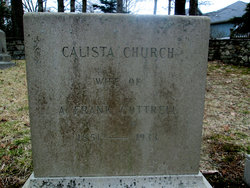 About the time the seven Ringling Brothers went into the circus business, the seven Church brothers began fishing for menhaden. Their names were Daniel, Isaac, Joseph, James, Nathaniel, George, and Fisher. Their only sister, Calista, ran the cookhouse at the factory and was as famous as any of her brothers. They were all the children of Captain Joseph Church and were of the eighth generation from Richard Church, who came over with Winthrop in 1630. Their mother had been Jemima Boomer of Fall River.
About the time the seven Ringling Brothers went into the circus business, the seven Church brothers began fishing for menhaden. Their names were Daniel, Isaac, Joseph, James, Nathaniel, George, and Fisher. Their only sister, Calista, ran the cookhouse at the factory and was as famous as any of her brothers. They were all the children of Captain Joseph Church and were of the eighth generation from Richard Church, who came over with Winthrop in 1630. Their mother had been Jemima Boomer of Fall River.
In 1870 Joseph Church & Sons was incorporated, but was always known as the Seven Brothers. They bought a pogy factory on the Maine coast, but dismantled it in 1878 and used some of its parts in building their factory in the Common Fence Point area of Portsmouth. They employed about 250 people at that factory just above the railroad bridge. In the late 1800’s and early 1900’s, they sent their big fleet of pogie boats far up and down the Atlantic coast to catch the menhaden. In those years, you couldn’t go anywhere along Narragansett Bay or the Rhode Island coast without seeing a covey of these boats closing in on a school of pogies. The Church brothers got most of the menhaden business in Rhode Island into their hands. At the factory, the fish were reduced to two products: oil to make into soap, and what was called “fish pumice” or “fish guano” to be sold as fertilizer.
Calista Church, born in 1855, married Tiverton’s Abraham Frank Cottrell in 1875. He was a fisherman who worked as superintendent in several fish factories in Portsmouth and at Linekin, Maine. She ran the cookhouses to feed all hands who worked at the pogy factory. The cook room was at least thirty-five feet square and there were two large dining rooms. At some seasons, she cooked and served three meals a day to three hundred men. On Saturday nights in summer people would come from their cottages on Common Fence Point to buy her famous baked beans and brown bread. Her clam chowder was famous also. When her brother, Captain Nat, gave one of his big clambakes at Nanaquaket, she came early to make the chowder. She was in charge of the cookhouses from 1880 to 1906, when she left to run her own household of five children.
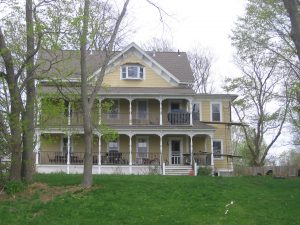 Calista died in 1933 and is buried in the Church family cemetery in Tiverton, along with her husband Frank and their two daughters, Mary and Calista. Her house still stands on a hill in Tiverton near Route 24 overlooking Common Fence Point where she used to work.
Calista died in 1933 and is buried in the Church family cemetery in Tiverton, along with her husband Frank and their two daughters, Mary and Calista. Her house still stands on a hill in Tiverton near Route 24 overlooking Common Fence Point where she used to work.
* * * * * * * * * * * * * * * * * *
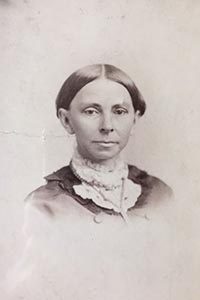 Tiverton owes the backbone of its public library to Lydia B. Essex. Lydia was born in New Bedford in 1861, and the family spent their summers in their small cottage on Highland Road in Tiverton Heights.
Tiverton owes the backbone of its public library to Lydia B. Essex. Lydia was born in New Bedford in 1861, and the family spent their summers in their small cottage on Highland Road in Tiverton Heights.
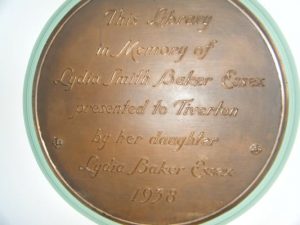 Apparently, Lydia loved Tiverton so much that she bequeathed the family estate, consisting of the cottage and 300 rods of land to the Town of Tiverton in her will that she wrote in 1935: I give, devise and bequeath said rest and residue including all my right, title and interest in the real estate on Highland Road in the Town of Tiverton in the State of Rhode Island, to the Town of Tiverton for the erection and equipment thereon of a library building as a memorial to my mother, Lydia Smith Baker Essex, and the building to be so marked or identified. It is my wish that a library building may be constructed of stone similar in design to Russell Library in the Town of Acushnet, Massachusetts. If at the time of my decease the personal property in my estate shall be insufficient to erect and equip a library building as above, then it is my wish and desire that the same may be allowed to accumulate until such time as said personal property with its accumulations shall be sufficient to erect and equip a library building as aforesaid and any balance shall be used for the maintenance of said library. This gift or devise to the Town of Tiverton is made upon the condition that the said Town of Tiverton shall accept the gift within one year after the decease of my said sister, Estelle W. Essex, or within one year after my decease if my sister shall predecease me, but said Town of Tiverton may elect to accept only the real estate without the personal property for a library in which event said real estate to be used for some public purpose other than the erection or maintenance thereon of a police station or fire engine house.
Apparently, Lydia loved Tiverton so much that she bequeathed the family estate, consisting of the cottage and 300 rods of land to the Town of Tiverton in her will that she wrote in 1935: I give, devise and bequeath said rest and residue including all my right, title and interest in the real estate on Highland Road in the Town of Tiverton in the State of Rhode Island, to the Town of Tiverton for the erection and equipment thereon of a library building as a memorial to my mother, Lydia Smith Baker Essex, and the building to be so marked or identified. It is my wish that a library building may be constructed of stone similar in design to Russell Library in the Town of Acushnet, Massachusetts. If at the time of my decease the personal property in my estate shall be insufficient to erect and equip a library building as above, then it is my wish and desire that the same may be allowed to accumulate until such time as said personal property with its accumulations shall be sufficient to erect and equip a library building as aforesaid and any balance shall be used for the maintenance of said library. This gift or devise to the Town of Tiverton is made upon the condition that the said Town of Tiverton shall accept the gift within one year after the decease of my said sister, Estelle W. Essex, or within one year after my decease if my sister shall predecease me, but said Town of Tiverton may elect to accept only the real estate without the personal property for a library in which event said real estate to be used for some public purpose other than the erection or maintenance thereon of a police station or fire engine house.
Her sister died in 1935, and Lydia followed her the next year. Approximately $42,000 was left to the Town with the 2-acre lot of land upon her death, accepted at a Town meeting in 1937. Income from her bequest was being used to purchase books up to 1976. It is unknown if this income continued after that.
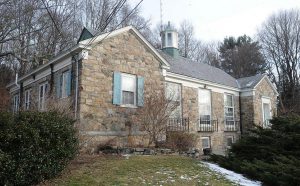 Prior to her death, Whitridge Hall on Lawton Avenue provided the library for this part of Town, known as “The Whitridge Hall Public Library”. Charles F. Seabury served as its first supervisor in 1879, having owned the land previously. His daughter, Mary Stimson, succeeded him as librarian for the next fifty years. When the new Essex Library was built on Highland Road, the collection of books moved from Whitridge Hall to this new library space and grew from there, thanks to Lydia’s endowment for future book purchases.
Prior to her death, Whitridge Hall on Lawton Avenue provided the library for this part of Town, known as “The Whitridge Hall Public Library”. Charles F. Seabury served as its first supervisor in 1879, having owned the land previously. His daughter, Mary Stimson, succeeded him as librarian for the next fifty years. When the new Essex Library was built on Highland Road, the collection of books moved from Whitridge Hall to this new library space and grew from there, thanks to Lydia’s endowment for future book purchases.
